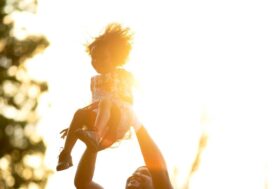Music in the classroom for children from birth to six


Una Shea, Founder, Our Montessori Melodies
As educators, we find ourselves always looking for new ways to encourage the development of our students’ abilities and wellbeing. This is a challenge in itself, especially in times such as these, where unprecedented levels of stress are being reported worldwide (Racine et al., 2021). Including group creative experiences, such as vocal or instrumental music-making, is proven to help to manage anxiety and stress in all ages, while also elevating feelings of community acceptance (Judd and Pooley, 2013; Kirschner and Tomasello, 2010; Boer and Abubakar, 2014). Bearing this in mind, why shouldn’t we be working to find time to intentionally include making music in our classrooms and homes?
Dr Montessori intended that music be presented in the same manner as other academic subjects. This can be seen discussed in more detail in the newly published book The Montessori Approach to Music (Montessori, 2020). However, in many cases, music is avoided by classroom teachers and is instead presented by a visiting music specialist. While formal learning contexts are extremely valuable, this does not need to be the only time that music is included in a child’s routine. As adults, it can be challenging to think about presenting music, as it seems inaccessible to learn unless it is already a skill that one possesses. However, it is our responsibility as educators to continue to challenge ourselves to learn and grow, just as we encourage the children around us to do.
In Montessori classrooms designed for children in the first plane of development – children from birth until around the age of six – there are a selection of materials that aim to develop each child’s aural awareness. In the classrooms for children under three years who are not yet walking (Nido) and those who have begun to walk (Walking Community), musical instruments are used as a vessel for collaboration, movement and language, and come in the form of hand-held percussion instruments or sturdy instruments like pianos, guitars or ukuleles. For children aged three to six (in the Children’s House), there are materials such as the sound boxes, which work with volume discernment. The bells challenge the child’s pitch awareness and develop their auditory skills when matching the black and white set to the brown. Both of these materials are wonderful additions and provide valuable sensorial information. These presentations are learned during Montessori teacher training with the Association Montessori Internationale (AMI), but music can be included in a plethora of ways and for a huge variety of other benefits as well.
Participating in music can be a valuable tool when it comes to language development (Brandt et al., 2012; Kraus et al., 2014). Singing songs is yet another way by which we can cater to what is defined by Dr Montessori as the sensitive period for language. A sensitive period is a developmental phase in which every child will be innately drawn to specific experiences involving language and/or sensory information. Knowing that children from birth to six have a natural pull towards language, we can encourage the children around us to hear, replicate and repeat it in a creative environment. Below are examples of ways in which music and movement can be used to support language development, motor skills and emotional regulation.
One example of using singing to develop language is through participatory songs. These come in many forms, such as Old McDonald Had a Farm, and give the children the chance to give input into how the song goes. This encourages the development of memory recall, either with or without visual stimulation, and asks the children to synthesise farm-related vocabulary, so with younger students, it may be more appropriate to utilise participation through the animal sounds section. You can also sing songs that include the names of the children in your environment. This can come in many forms, one of which could be a hello or goodbye song used at the beginning or end of the day.
Using music as an aid for transition can benefit young children, as it serves as a point of reference during the daily routine. In many circumstances this will yield some moments of calm in times of day that tend to become chaotic. For example, a song of gratitude before beginning lunch provides an understandable benchmark and gives every child the time to be ready and seated before the meal begins. Although it is only a brief moment, it is a conscious expression of gratitude and a moment for the group as a whole to take a moment to settle before beginning to eat.
Singable books, such as What a Wonderful World by Bob Thiele and George David Weiss, Every Little Thing by Cedella Marley and Luna (De la Cuna a la Luna) by Antonio Rubio Herrero, are another way in which to assist in language development. They can be presented as a song to sing or a song to listen to, and can help to develop print awareness for children who are around the ages of three to six years. It can also be the perfect opportunity to introduce the children in your community to a variety of cultures and include songs in different languages. These can be a valuable addition to a group presentation, or can be included in a reading area – once they are familiar, children will choose to browse and sing them independently.
An extension of this could be to read books about specific musicians, such as the soon-to-be-published How Evelynn Glennie, a Deaf Girl, Changed Percussion by Shannon Stocker, and then listen to some of their music together. This provides the opportunity to learn about important aspects of different cultures and abilities. Encouraging diversityThe recognition of individual differences in terms of race, ... More in this way should be intentionally done, as it is important that music and art are illustrated as a multi-faceted creative space where nobody is excluded and everyone’s abilities and backgrounds are celebrated. Over time, you could include the music that you learn about in these lessons in the songs that you sing together.
Another way in which music can be used in the classroom is in conjunction with movement. This can be through participatory songs such as Head, Shoulders, Knees and Toes, or can be done either to music recordings or live music, such as a CD of a specific musician, digital music or while an individual plays piano or guitar in the classroom. Not only will this boost mood but it will also give the children the opportunity to develop gross motor skills and physical balance. When dancing to music, it is generally more successful to model movements to be replicated before encouraging free movement, as this can escalate quickly as the children enjoy themselves. Especially in the first plane of development (birth to six years), emotional regulation has not quite been mastered; when children of this age become energised, it can become very loud and overwhelming very quickly. With this in mind, it can be a great opportunity to offer the chance to children to lead the group themselves, highlighting their independence.
Music and movement can be used with great success to assist in emotional regulation (Shifriss et al., 2014; Thoma et al., 2012). Having the opportunity to move one’s body in a constructive and expressive way provides an outlet to release tension in a physical way that is still appropriate for an inside space. This can prove as quite a useful tool for those who are still developing their ability to regulate their emotions.
Even though many music-making experiences lie outside the predetermined Montessori curriculum, we can still present these moments of creativity in the manner in which materials are presented. First and foremost, music is a collaborative experience. In the spirit of a prepared environment, it is likely that the adult will be interested in pre-planning a musical experience, especially if you are new to leading informal music-making. This will give you a structure from which to work. However, be careful how you do so.
In order to have true collaboration with the children in your environment, be sure that you are taking into consideration what arouses a positive, child-led response instead of simply making a plan that works for you. Flexibility will be your best friend when making music with children, as ‘following the child’ will from time to time require some ad-libbing or creative thinking on the spot. As long as you are observing and noting what the children enjoy, this can still be a useful tool, but be sure to have a few back-up plans in case the situation calls for a quick change.
When we talk about making music together, there are many benefits that come to mind. Research has shown that groups who participate in singing or instrumental ensembles gain a strengthened sense of community. However, this is only true if all participants are willing. For those who are shy, anxious or unsure, the emotional demands of participation can bring adverse results. As teachers and music-makers, we want to encourage those around us to take advantage of those benefits, but we need to be sure to respect the boundaries of those who need time to warm up to new experiences. If some children would prefer to watch and listen, let them. As long as there is no anti-social behaviour, invite those individuals to sit and observe. In this instance, your respect for their boundaries is exemplifying your respect for them. Remember: passive participation through observation is still participation!
Making music with children can be such a joyful experience, and has the potential to bring out abundant positive energy from your community. It is not mandatory to be a musical genius to integrate music-making. Even informal experiences will still yield many psychological and physical benefits for the environment – for both children and adults alike.
References
- Boer D and Abubakar A (2014) Music listening in families and peer groups: Benefits for young people’s social cohesion and emotional well-being across four cultures. Frontiers in Psychology 5: 392.
- Brandt A, Gebrian M and Slevc LR (2012) Music and early language acquisition. Frontiers in Psychology 3: 327.
- Judd M and Pooley JA (2013) The psychological benefits of participating in group singing for members of the general public. Psychology of Music 42(2): 269–283.
- Kirschner S and Tomasello M (2010) Joint music making promotes prosocial behavior in 4-year-old children. Evolution and Human Behavior 31(5): 354–364.
- Kraus N, Hornickel J, Strait DL et al. (2014) Engagement in community music classes sparks neuroplasticity and language development in children from disadvantaged backgrounds. Frontiers in Psychology 5.
- Marley C with Newton V and Marley B (2015) Every Little Thing. San Francisco: Chronicle Books.
- Montessori M (2020) The Montessori Approach to Music. Amsterdam: Montessori-Pierson Publishing Company.
- Racine N, McArthur BA, Cooke JE et al. (2021) Global prevalence of depressive and anxiety symptoms in children and adolescents during COVID-19. JAMA Pediatrics 175(11): 1142–1150.
- Rubio A with Villán Ó (2021) Luna. Pontevedra: Kalandraka Editora.
- Shifriss R, Bodner E and Palgi Y (2014) When you’re down and troubled: Views on the regulatory power of music. Psychology of Music 43(6): 793–807.
- Thiele B and Weiss GD (trans: Hopgood T) (2015) What a Wonderful World. Oxford: Oxford University Press.
- Thoma MV, Ryf S, Mohiyeddini C et al. (2012) Emotion regulation through listening to music in everyday situations. Cognition & Emotion 26(3): 550–560.










